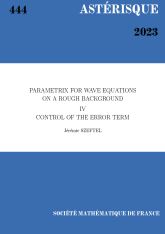Schur quadrics, cubic surfaces and rank 2 vector bundles over the projective plane
Schur quadrics, cubic surfaces and rank 2 vector bundles over the projective plane
Astérisque | 1993
- Consulter un extrait
- Année : 1993
- Tome : 218
- Format : Électronique
- Langue de l'ouvrage :
Anglais - Class. Math. : 14J60
- Pages : 111-144
- DOI : 10.24033/ast.242


